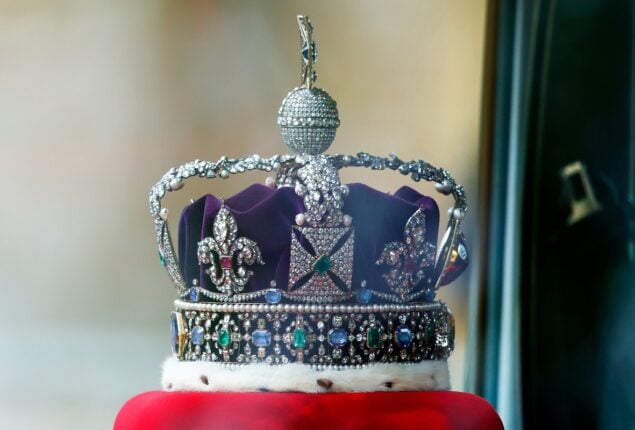The famous diamond crown of the queen is displayed in public
The public can again visit Buckingham Palace once more, but there have...

Everything you need to know about Royal Crown Jewels
The Crown Jewels, which serve as the focal point of the coronation ceremony, stand for the grandeur and long history of the British monarchy.
The Imperial State Crown
The crown was ordered for the 1937 coronation of King George VI.
Following her coronation, Queen Elizabeth II wore it to formal occasions including the official opening of parliament.
2,868 diamonds, 269 pearls, 17 sapphires, and 11 emeralds are embedded in the crown.
It measures 31.5 centimeters (12.4 inches) in height and weighs 1,060 grammes (2.3 pounds).
The front is embellished with the second-largest stone ever extracted from the Cullinan Diamond, the biggest diamond ever mined.
The Sovereign’s Sceptre
The sceptre’s design, a gold rod with a globe, cross, and dove at the top, represents the Christian Holy Ghost.
It is connected to the monarch’s pastoral responsibilities to the populace.
It measures 110.2 centimeters in length and weighs 1,150 kilos.
The sceptre complements the spiritual power symbolized by the Sovereign’s Sceptre with Cross by representing the monarch’s temporal power and sound government.
It measures 92.2 centimeters in length and weighs 1,170 kilos.
The Cullinan I, the largest colorless cut diamond in the world, is at the top. It is 106 grammes in weight and is referred to as the “First Star of Africa.”
The sceptre had to be strengthened in 1910 due to the weight of the diamond.
The Sovereign’s Orb
The orb stands for both the Christian world and the authority of the monarch.
A belt made of diamonds, emeralds, rubies, sapphires, and pearls surrounds the gold piece of jewellery, which is crowned with an amethyst and a cross.
It is 27.5 centimeters tall and 1,320 grammes in weight.
The gold Ampulla
The sacred oil used in coronation rituals is kept in the eagle-shaped container.
Oil can be poured into the vessel by removing the eagle’s head.
A tradition claims that the Virgin Mary appeared to the mediaeval English saint Thomas Becket and gave him a golden eagle and oil to anoint future English kings. This design is based on that narrative.
It is 660 grammes in weight and 20.7 x 10.4 centimeters in size.
The Spurs
One of the oldest components of the ceremonial attire used at British royal coronations is made of gold, leather, velvet, and gold thread.
Since Richard I’s coronation in 1189, spurs have been used to symbolize knighthood during inaugurations.
Traditionally, during coronation rituals, spurs were affixed to the feet of the monarch; however, for queens, they were gifted and set on the altar.
The Cullinan Diamond
When it was found in South Africa in 1905, it weighed 621 grammes in its uncut state and was the biggest diamond ever mined.
In 1907, on the occasion of King Edward VII’s 66th birthday, the Transvaal government gave it to him as a sign of goodwill following the Second Boer War (1899-1902).
For eight months, three Asschers of Amsterdam workmen put in 14-hour shifts to cut and polish nine sizable stones from the original gem.
When the cutting process started, the initial blow broke the knife instead of the diamond.
St Edward’s Crown
Following the destruction of the previous mediaeval crown by parliamentarian rebels in 1649 during the English Civil War, crown jeweller Robert Viner created a new one in 1661 for the coronation of King Charles II.
The solid gold crown was too hefty for monarchs to wear during coronation ceremonies for more than 200 years.
It measures 30.2 centimeters in height and weighs 2,040 grammes.
Coronation ring
The ring was presented to King William IV after his coronation in 1831.
Due to her short fingers, Queen Victoria did not wear it for her coronation in 1838.
Purple Robe of Estate
3,500 hours were spent on its creation by twelve seamstresses from the Royal School of Needlework.
The monarch’s cypher, wheat ears, and olive branches are stitched on the silk robe.
The Stone of Scone
It is also referred to as the “Stone of Destiny” and is the traditional emblem of the Scottish monarchy.
The chunk of sandstone weights 152 kilos (335.1 pounds).
It was taken in 1296 by English monarch Edward I and added to his throne at Westminster, London.
It was stolen by Scottish nationalists from Westminster Abbey in London in 1950, but it eventually turned up in Arbroath Abbey in Scotland. In 1996, it was formally given back to Scotland.
Only once more, for a coronation at Westminster Abbey, will the stone go from Scotland.
Catch all the Entertainment News, Royal Family News, Breaking News Event and Latest News Updates on The BOL News
Download The BOL News App to get the Daily News Update & Follow us on Google News.